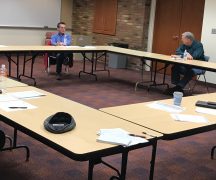By Susan Tebben
The Cleveland Metropolitan School District’s leadership and union officials received their shots last week in what they see as a show of confidence in the vaccine the state is trying to get in the arms of school personnel statewide in less than a month.
“We’re definitely encouraging everyone to get it and we’re trying to lead by example,” said Shari Obrenski, president of the Cleveland Teachers Union, among those that received the vaccine.
But they were one of three schools chastised by Gov. Mike DeWine in a sudden Friday evening press conference that focused mainly on reminding schools of the promise they made about reopening, in order to receive vaccinations.
Under a deadline imposed by DeWine, personnel in the Cleveland district and all others in the state must be back for hybrid or totally in-person instruction by March 1.
“We have learned that there are a handful of schools that have indicated that they will break that promise,” DeWine said.
Akron schools and Walnut Hills High School in the Cincinnati school district were also called out as having agreed to open in at least a hybrid model by March 1, but planning to continue in a remote model.
“That simply is not acceptable,” DeWine said.
As of now, less than 15% of Ohio schools are in fully-remote models.
K-12 vaccinations began at the beginning of the month, and Akron and Cincinnati public schools have all completed their vaccinations. But some schools are not scheduled to begin their vaccinations until Feb. 22. The last group includes seven schools in Clinton County, which currently stands as the second-highest county in cases per capita, according to state data.
The Cleveland Metro school district expects to distribute a little more than 3,000 first-dose vaccines to personnel.
The district itself is made up of 7,000 employees, but the vaccines aren’t just going to those within the district who choose to take it. CMSD is also the source of vaccines for private, parochial and charter schools in the area, according to Obrenski.
“We are so close (to the deadline) that it is entirely possible that people may not have their first round by March 1, let alone their second,” Obrenski said.
March 1 goal
CMSD is one district among the 609 public school districts in the state, as reported by state schools superintendent Paolo DeMaria on Thursday during education budget discussions.
Outside of public school districts, the state also has 49 joint vocational schools, 315 community schools and 51 educational service centers serving nearly 2 million students.
In the 4,200 school buildings in the state, there are a total of 111,000 licensed teachers, according to DeMaria. The state education system includes 329,000 “credentialed educational personnel,” which also includes principals, administrators, aides, counselors, coaches and other staff.
On Friday as he emphasized the need for schools to be back in their facilities by March 1, DeWine noted that the number of doses that were set aside for schools, of the roughly 200,000 per week the state is receiving as a whole, is about 60,000.
That number may go up, with last week’s reports that 200 million more vaccine doses will be distributed nationwide by the end of July, though whether those doses will impact the March deadline is unclear.
The governor has been unequivocal on his deadline, citing the importance of getting students back to a more traditional way of learning.
But he’s also said the March 1 date was agreed upon by his administration as a date that would give schools enough time to prepare for a return to school, but doesn’t have any other significance.
“There’s nothing magical about (March 1), it’s just the cycle as we were moving forward,” DeWine said.
The governor said the vaccination schedule for schools is “right on schedule,” but those that choose not to commit to the deadline could see their doses go back into the pile for general distribution.
“Nobody compelled schools to do this,” DeWine said it. “They had a choice, if you want everyone to be vaccinated that wants to be vaccinated, then sign this, and you’re agreeing to come back to school and back March 1.”
When questioned about the deadline in a budget hearing on Thursday, Ohio Superintendent of Public Instruction Paolo DeMaria said he understood the in-person requirement as a “request” and one that could include a hybrid approach, rather than just a five-day in-person directive.
“I think the way the governor has framed his request of the education community has not necessarily gone so far as to require five-day, every day return to learning,” DeMaria said. “I think he allowed for hybrid approaches, especially recognizing that going from fully remote to fully five-day in-session may not be practical from a number of approaches, whether it’s social distancing or what-have-you.”
DeMaria also said though the governor has created a requirement that these school districts agree to get back to in-person instruction in order to get vaccinations, he supports communities making their own decisions in schools when it comes to risk factors related to COVID-19.
“At the end of the day, I’d rather err on the side of local control than somehow put the state in a position of forcing people to do things that ultimately may not make sense,” DeMaria said.
For/Against the plan
Officials from the state teachers’ unions have said they support having a goal to reopen schools, but say the vaccination pre-requisite isn’t the way to go about it. Other state and federal officials are on board with moving quickly to get students back in school, but differ on how it should be done.
The state Board of Education passed a resolution on Feb. 10 calling on local school boards to “provide where feasible a fully in-person, non-hybrid learning option for children of all families who desire it.”
“Innovations in virtual learning have opened doors of possibility for many students and revealed new ways of supplementing in-person learning, but there seems to be consensus that for most students in-person learning is instrumental for maximizing their growth and development,” the resolution reads.
Political officials like Democratic Ohio U.S. Sen. Sherrod Brown say schools need to get back to in-person instruction, but he blames a lack of funding on the federal level and a “19th Century legislature that continues to underperform or perform in their own direction” for the delay in getting back to classrooms.
“I support the idea of opening the schools as quickly as they can, I think they’d be open now if the Senate had done its job last year to get money to local governments,” Brown said in a recent press call. “Nothing’s more important than getting young people in-person back in the classroom, but that means teachers vaccinated and enough money that school districts can do what they have to do.”
Republican Ohio U.S. Sen. Rob Portman said “the science is clear” that it’s time to reopen schools, citing comments by CDC Director Dr. Rochelle Walensky, who said vaccinating teachers “is not a prerequisite for safely reopening schools.”
DeWine echoed those comments on Friday saying the CDC “is saying you don’t even need a vaccine” to have a safe school environment.
The Biden administration attempted to walk-back Walensky’s comments, deferring to official guidance from the CDC, which was updated on Friday. That guidance said community transmission levels should be a part of the decision-making for reopening schools, and mitigation strategies should include vaccination.
“Teachers and school staff hold jobs critical to the continued functioning of society and are at potential occupational risk of exposure to (COVID-19),” the guidance states. “(State and local) officials should consider giving high priority to teachers in phase 1b.”
In Ohio, five of the districts with the highest student COVID-19 cases also have the highest staff cases, as reported in the state’s most recent school case data.
Cincinnati Public Schools, which started its teacher vaccine testing first, reported a total of 512 staff cases as of Feb. 11. The school reported a total of 380 student cases in the same report, which covers all cases reported since the beginning of the pandemic.
Franklin County’s highest-reporting schools both reported more than nearly 200 staff cases. Dublin City Schools had 192 cases, with 582 student cases at last count, and Hilliard City Schools had 191 staff cases, along with 597 student cases overall.
Other support
DeWine has said other than the three schools he mentioned at Friday’s press conference, district distribution has “gone very well.”
While school officials agree vaccinations will help bring protection from the virus, and there’s more that has to happen for them to feel safe in their schools.
In the Cleveland Metro school system, Obrenski said their district has been as supportive as possible with keeping track of available personal protective equipment, and the union and the district plan to go through documentation of ventilation inspections as well “to ensure that the appropriate measures have been taken.”
When DeWine was told during Friday’s press conference that Hamilton County’s Walnut Hills had decided to continue remotely because of spacing issues, he said that should have been discussed earlier on in the planning process.
“They signed the document, they said they were going to go back in,” DeWine said.
But a bigger issue that needs work on a state level is testing and contact tracing, according to Obrenski.
“Ohio has been…not the best when it comes to testing and tracing, and that’s an important part of keeping the virus down,” Obrenski said.
The state says it is continuing diagnostic testing, reporting them broken down into confirmatory lab tests, presumptive lab tests, and as a combination of both. As of Feb. 9, state testing data showed a total of 56,366 people tested, with a daily percent positive of 4.8%, which was part of a decline in testing. The seven-day average of test positivity was 5.5%.
The most recent peak in testing was Nov. 25, when 90,691 tests were conducted, with a daily positivity of 11.2% and a seven-day average of 11.9%.
***
Also from Ohio Capital Journal:
Census data delays may significantly impact Ohio redistricting process
Delays in processing the 2020 U.S. Census data will likely impact Ohio’s ability to redraw legislative districts later this year.
The U.S. Census Bureau announced last Friday it has pushed back the deadline to release population data to Sept. 30, months later than was originally expected, due to the pandemic.
The delay could pose major problems for the Ohio redistricting process, which was completely overhauled after voters approved reforms in recent years.
Legislative maps for the Ohio General Assembly and the U.S. House of Representatives are redrawn every 10 years. Ohio’s new process is set to be used for the first time this year, with fresh maps in place for the 2022 election cycle. (Flow charts detailing the redistricting process in Ohio are included at the conclusion of this article.)
The biggest impact of the delay is likely to affect the state legislative map: 99 districts in the Ohio House of Representatives and 33 districts in the Ohio Senate. READ MORE
DeWine aide’s organization was link to now-guilty dark money group
Dan McCarthy, a top aide to Gov. Mike DeWine, hasn’t explained what he thought the point was of the millions funneling through a dark money group he founded and into another at the heart of a huge corruption scandal that has rocked Ohio. He did say, however, that he had no reason to believe it was anything improper.
But the fact that the other dark money group has now pleaded guilty to its role in the corrupt scheme raises questions about what McCarthy did believe the purpose was, if not to conceal the fact that an Ohio utility was financing a scheme to make ratepayers bail out two nuclear reactors it began spinning off a year earlier.
Generation Now, a 501(c)(4) group, was incorporated in early 2017 under a part of the federal tax code that protected it from disclosing its contributors.
Even so, it pleaded guilty earlier this month after federal prosecutors accused it of illegally taking $60 million from Akron-based FirstEnergy and associated groups. It funneled the money into an effort to make Rep. Larry Householder, R-Glenford, speaker and pass a $1.3 billion bailout that mostly went to prop up two nuclear power plants that FirstEnergy began spinning off in 2016. READ MORE
Bill would enhance Ohio vandalism penalties in response to 2020 damage
A Republican state senator is seeking to increase the penalties for arson, vandalism and other criminal acts as a response to damage caused to the Ohio Statehouse and nearby businesses last year.
Sen. Andrew Brenner, R-Powell, said the recent storming of the U.S. Capitol also spurred his desire to sponsor Senate Bill 34 last week. The bill would elevate the criminal penalties for certain acts of arson, disrupting public services, criminal damaging or endangering, vandalism and criminal mischief.
Brenner noted the “widespread property damage incurred by many downtown businesses, including our very own Statehouse, during the weeks and months of protests last spring and summer.”
Repairs from the Ohio Statehouse damages totaled $158,263, the Capital Square Review and Advisory Board (CSRAB) reported last summer. This included damage to windows, doors, pole lights and trash cans, as well as the cost to remove red handprints that were left on the granite and marble monuments.
When all the surrounding area’s property damage is included, the total damage well exceeded $1 million, The Columbus Dispatch reported. READ MORE





